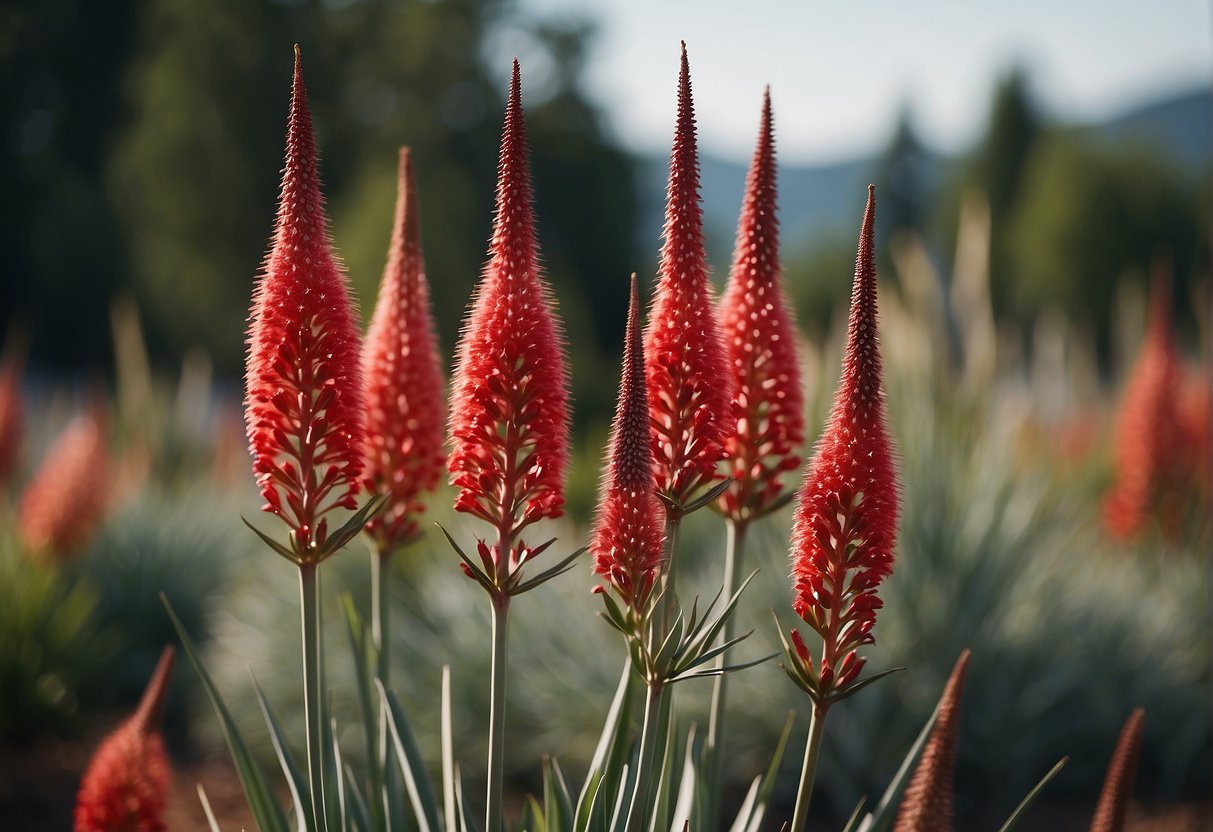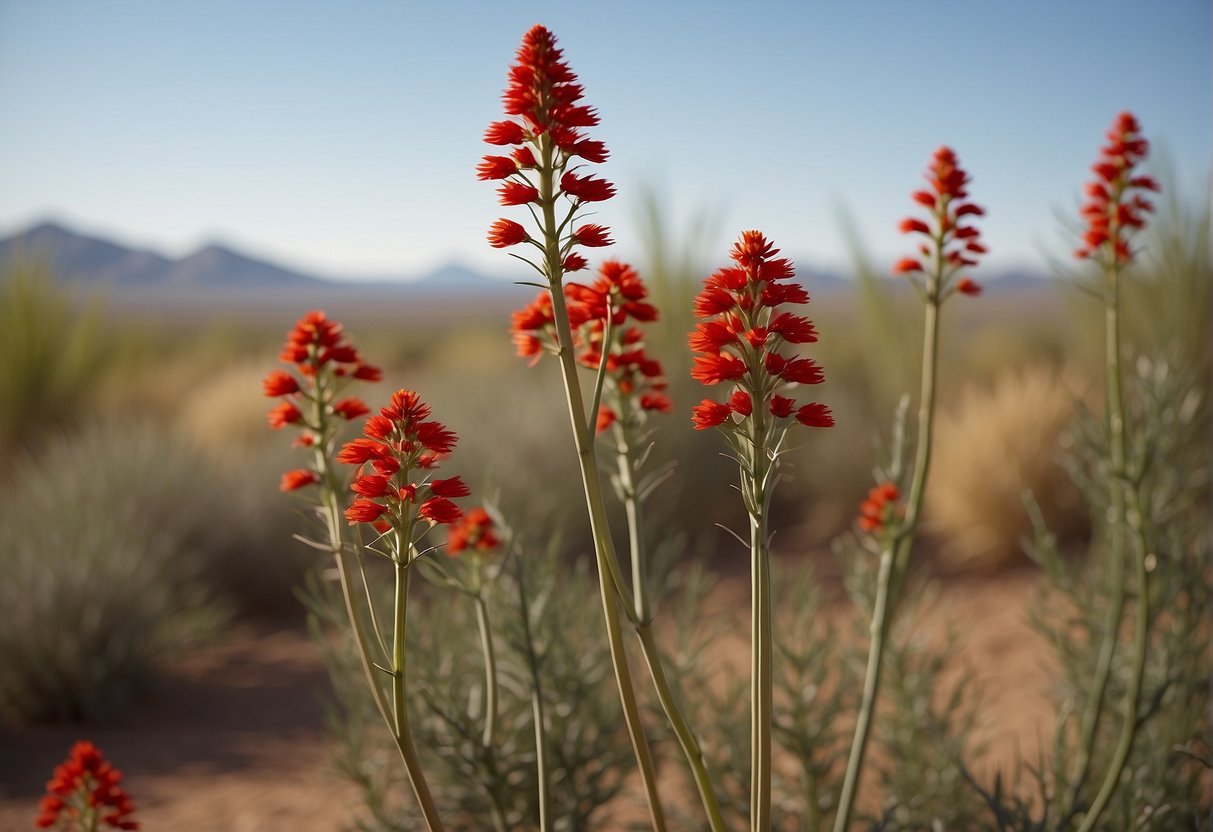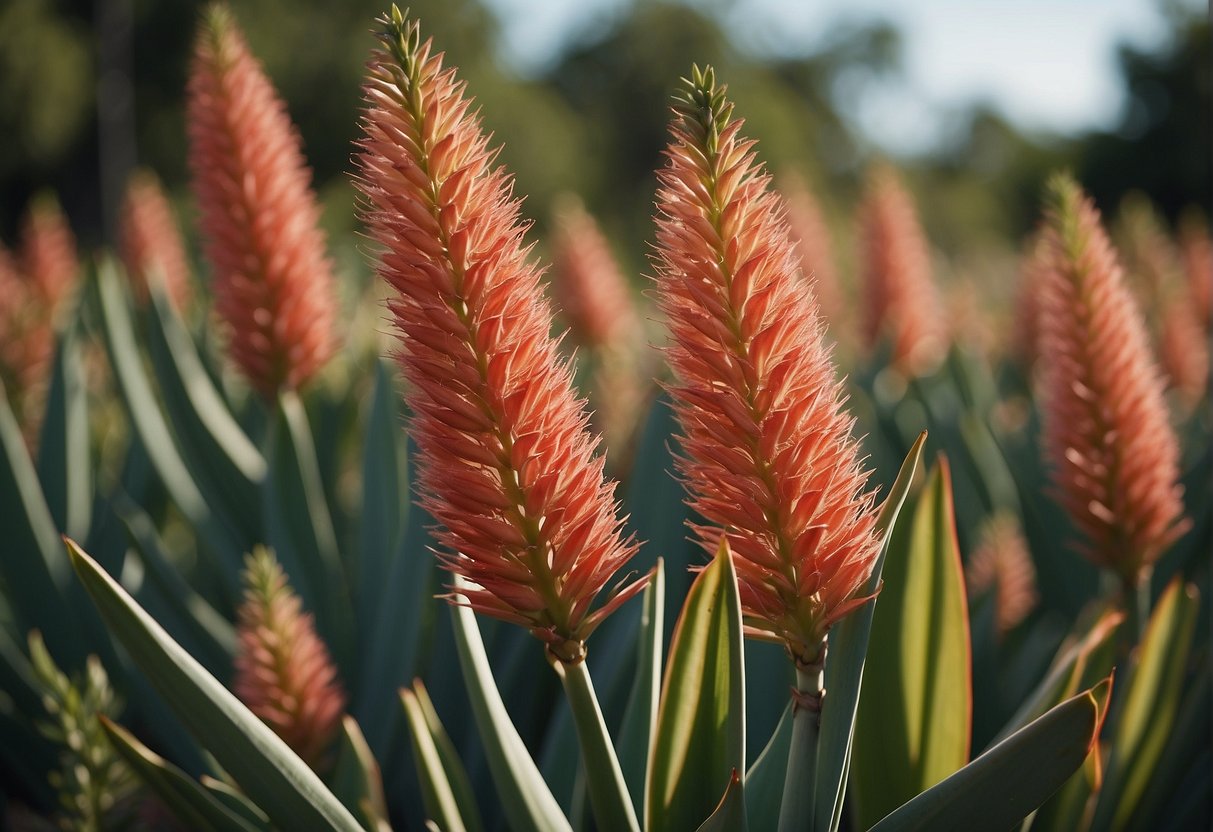What Do Red Yucca Plants Look Like: A Visual Guide
If you’re in search of a distinctive and eye-catching addition to your garden, consider the red yucca. This succulent bush, known scientifically as Hesperaloe parviflora, originates from the southwest region of the United States and northern parts of Mexico. Contrary to its common name, the red yucca doesn’t actually belong to the yucca species, but is instead part of the agave family.

One of the most distinctive features of the red yucca is its tall, slender flower stalks. These can grow up to 5 feet tall and are covered in small, tubular flowers that range in color from pale pink to deep red. The leaves of the plant are long and narrow, with a bluish-green color and a slight curl at the tips. The overall effect is a striking and sculptural plant that is sure to catch the eye.
Key Takeaways
- The red yucca is a visually striking succulent shrub that is native to the southwestern United States and northern Mexico.
- One of its most distinctive features is its tall, slender flower stalks covered in small, tubular flowers that range in color from pale pink to deep red.
- The plant’s long, narrow leaves have a bluish-green color and a slight curl at the tips, creating a sculptural effect.
Physical Characteristics

Red yucca plants are known for their unique and stunning appearance. This evergreen plant features sword-shaped leaves that grow in a rosette formation. The leaves are typically green, but some varieties may have a bluish tint. They can grow up to 3 feet tall and 2 feet wide, making them a great addition to any garden or landscape.
Foliage Description
The foliage of the red yucca plant is one of its most distinctive features. The leaves are long and narrow, with pointed tips and a slightly curved shape. They are arranged in a rosette formation, creating a symmetrical and balanced look. The leaves are evergreen, meaning they stay green all year round, providing color and texture to your garden even in the winter months.
Flower Description
The red yucca plant is known for its beautiful and vibrant flowers. The flowers grow on tall stalks that can reach up to 5 feet tall. They bloom in the summer months and can last for several weeks. The flowers are trumpet-shaped and come in a range of colors, including red, pink, and yellow. The flower color may vary depending on the variety of the plant.
In conclusion, the red yucca plant is a unique and stunning addition to any garden or landscape. Its sword-shaped leaves and vibrant flowers make it a standout plant that is sure to catch the eye. With its evergreen foliage, it provides year-round interest and color to your garden.
Growing Conditions

Light Requirements
Red yucca plants prefer full sun to partial shade, meaning they need at least six hours of direct sunlight per day. If you decide to plant them indoors, make sure they are near a window that gets plenty of natural light.
Soil and Watering Needs
Red yucca plants thrive in well-drained soil, so it’s crucial to ensure the soil is not too dense or compacted. Sandy soil with a pH range of 6.0 to 8.0 is ideal for these plants. They also require moderate watering, especially during the growing season. However, make sure the soil is not too wet or soggy, as this can lead to root rot.
When potting red yucca, make sure to use well-draining potting soil. You can add sand or perlite to the potting mix to improve drainage. It’s also essential to ensure that the pot has drainage holes to prevent water from accumulating at the bottom.
Temperature
Red yucca plants are succulents, meaning they are adapted to hot, dry climates. They can tolerate a wide range of temperatures, from 15°F to 110°F. However, they need protection during the winter months, as they are not frost-tolerant. If you live in an area with harsh winters, it’s best to plant them in containers that you can move indoors during the colder months.
Summary
In summary, red yucca plants require full sun to partial shade, well-drained soil, and moderate watering. They can tolerate a wide range of temperatures but need protection during the winter months. When potting them, make sure to use well-draining potting soil and ensure that the pot has drainage holes. With proper care, your red yucca plant will thrive and add a beautiful touch to your garden or indoor space.
Care and Maintenance
Taking care of your red yucca plant is relatively easy, and it can thrive in a variety of conditions. However, there are a few things you should keep in mind to ensure your plant stays healthy and happy.
Pruning and Repotting
Red yucca plants generally don’t require much pruning, but you can remove any dead or damaged leaves or flowers as needed. If you want to control the size or shape of your plant, you can trim back the stems in the spring before new growth appears.
Repotting is generally only necessary every 2-3 years, or when the plant has outgrown its current container. When repotting, choose a pot that is slightly larger than the current one and has good drainage. Make sure to use a well-draining potting mix and add a layer of gravel or sand to the bottom of the pot to improve drainage.
Pest and Disease Management
Red yucca plants are generally resistant to pests and diseases, but there are a few issues to watch out for. Spider mites and mealybugs can occasionally infest the plant, and you may notice yellowing or wilting leaves if the plant is overwatered or has poor drainage.
To prevent pest infestations, keep your plant clean and free of debris, and avoid overwatering. If you do notice pests, you can use a mild insecticidal soap or neem oil to treat the plant.
Overall, taking care of your red yucca plant is relatively easy and straightforward. With proper care and maintenance, your plant can thrive for years to come.
Propagation and Planting
Growing red yucca plants from seeds, cuttings, or offsets is relatively easy. Here are some tips to help you propagate and plant your red yucca plant.
Seed Germination
Red yucca seeds are relatively easy to germinate. You can either start them indoors or sow them directly into the ground. If you choose to start them indoors, you should start them 6-8 weeks before the last frost date. Here are the steps to follow:
- Soak the seeds in warm water for 24 hours.
- Fill a seed tray with well-draining soil.
- Plant the seeds about 1/4 inch deep.
- Cover the tray with plastic wrap to create a greenhouse effect.
- Keep the soil moist but not waterlogged.
- Once the seedlings have grown their first true leaves, you can transplant them into individual pots or directly into the ground.
Cuttings and Offsets
Red yucca plants can also be propagated through cuttings or offsets. Here are the steps to follow:
- Choose a healthy stem or offset.
- Cut the stem or offset with a sharp, clean knife.
- Let the cutting or offset dry for a day or two.
- Plant the cutting or offset in well-draining soil.
- Keep the soil moist but not waterlogged.
- Once the cutting or offset has taken root, you can transplant it into its permanent location.
It is important to note that red yucca plants are slow-growing, so it may take several years for them to reach their full size. However, once they are mature, they are quite hardy and require little maintenance.
Frequently Asked Questions
How can I identify a red yucca plant?
Red yucca plants are easily identifiable due to their unique appearance. They have long, narrow leaves that are green in color and grow in a rosette pattern. The leaves are rigid and have pointed tips, which can be sharp. The plant can grow up to 3-4 feet tall and wide. The flowers of the red yucca are trumpet-shaped and come in a variety of colors, including red, pink, and yellow.
What are the care requirements for a red yucca?
Red yucca plants are relatively low-maintenance and easy to care for. They prefer well-draining soil and do not tolerate wet feet. They are drought-tolerant and do not require frequent watering. However, they do benefit from occasional deep watering during periods of drought. They prefer full sun but can tolerate partial shade. Fertilization is not necessary, but a light application of a balanced fertilizer in the spring can promote healthy growth.
When does the red yucca typically bloom?
The red yucca typically blooms in the late spring or early summer and continues to bloom throughout the summer months. The flowers can last for several weeks and are attractive to hummingbirds and other pollinators.
Can red yucca plants become invasive?
Red yucca plants are not considered invasive, but they can spread through seed dispersal. It is important to deadhead the spent flowers to prevent self-seeding and unwanted spread.
What is the growth rate of a red yucca?
The growth rate of a red yucca can vary depending on growing conditions. In general, they are slow-growing plants and can take several years to reach their full size. However, with proper care and growing conditions, they can grow up to 3-4 feet tall and wide.
Does the red yucca prefer full sun or can it grow in shade?
Red yucca plants prefer full sun but can tolerate partial shade. They will not grow well in full shade and may become leggy or fail to bloom. If grown in partial shade, they may produce fewer flowers and have a more open growth habit.


